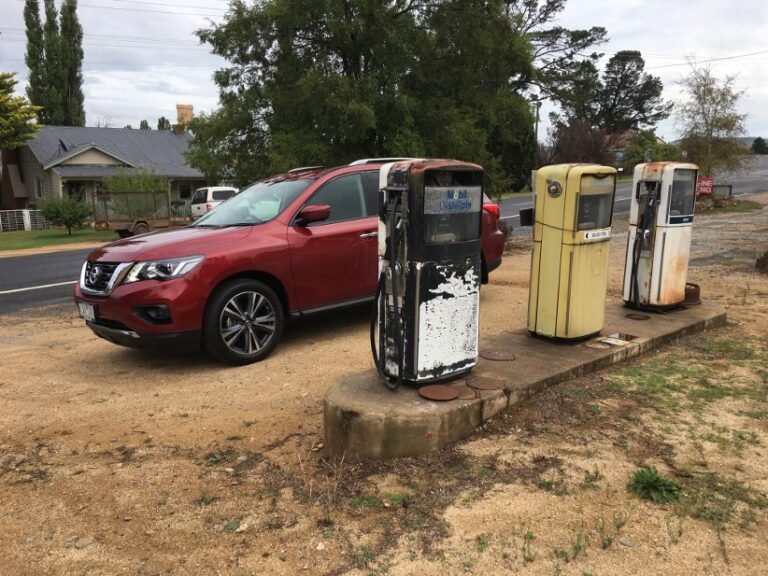– By David Brown –
Nissan is the third largest supplier of SUV vehicles in Australia and they say that they have the second largest range in their fleet. But Nissan feels their Pathfinder is the forgotten vehicle from the customer perspective.
It is classified as a large SUV, a segment that Toyota does very well with its Kluger (a more urban, family vehicle) and its Prado (strong four-wheel drive capabilities).
So to try and make a bigger impression in the market, Nissan has a new model.
The biggest change in the new Pathfinder is that 50% of the 3.5 litre V6 petrol engine components are new. For example, it now has a direct injection system. Combined together, this gives an additional 12 kW of power making a total of 202 Kw. Fuel consumption is rated at 10 litres per 100km.
There is also a hybrid option with an unusual configuration. It has a 2.5 litre 4-cylinder supercharged engine plus a 15kW electric motor – it is only available in four-wheel-drive. It is rated at 8.6 litres per 100km.
The Pathfinder is designed and built in America so no surprise that there is no diesel option.
All variations come with an automatic CVT gearbox. It is the third generation of this design from Nissan and has one great feature.
If you try to accelerate hard with a typical CVT, the engine revs up to its optimum power and stays there while the gear box continually and smoothly changes the ratio. But as most people are familiar with the engine revs going up and down as the vehicle steps through a fixed number of distinct gears, the CVT feels unnatural. This is most obvious when you are accelerating hard and you clearly hear the engine noise.
Some companies allow you to set the CVT to go in steps which feels more normal but if you have this feature on all the time, it defeats the purpose which is to be more fuel efficient.
Nissan’s D-step logic automatically creates a stepped function but only when the car is under full acceleration. Under light load you hardly hear the engine at all so the operation of the engine and gear box together is not that obvious. It is a good balance between operation and feeling comfortable.
From the driving perspective, the Pathfinder has a quicker steering response.
On the outside, there have been a few changes. The body is the same but its gets a signature grille, and LED driving lights. For up market versions, there are new designs for contrasting alloy wheels and razor turn indicators (I think that means they are narrow and thin).
A motion-activated electric-powered tailgate is provided in the top model. When you are carrying groceries you can wave your foot underneath the rear bumper bar and the tail gate opens automatically. But there are some conditions. The car has to be locked and you have to have the key in your pocket. So it’s best to learn the system well or you will end up looking like an idiot doing the hockey pockey in the car park at the back of your car.
The interior gives you seven seats and if you are using the ISO Fix child seat anchoring in the second row of seats, you do not have to remove the child seat to get into or out of the third row.
Inside the cabin, an 8-inch touch screen has replaced the previous 7 inch screen. The interface is quite simple but do we really need all the information they supply? You can see performance graphs such as the acceleration, braking and corning G forces, the instantaneous fuel economy and the instantaneous fuel flow.
Will you use these and do we want drivers looking at these when they should be looking at the road?
These features become almost galling when you realise the car does not have rain sensitive windscreen wipers nor Apple or Android car interfaces, in any of the variations.
The up-market versions do have 3D mapping graphics and multi-touch functionality which makes it more intuitive to use. Again, the more expensive variations have intelligent cruise control and heated and cool seats.
Driving around the city the Pathfinder is pretty typical of its class.
But we drove from the high country at Thredbo down to the coastal town of Merimbula on the Snowy Mountains then the Monaro Highway which are essentially secondary roads. Not just a straight boring motorway but flowing corners, occasionally becoming rather tight. There were rarely edge lines and occasionally no centre line. There didn’t appear to be much traffic so the road surface had not deteriorated greatly.
The Pathfinder was made for this territory. It was quiet and smooth. Ideal for family touring or for a comfortable ride if you have a lot of business kilometres to travel.
Only the very base model, the 2-wheel drive ST, has gone up in price, in this case by $500 to $42,000 plus on road costs.
To get a four-wheel drive will cost an extra $4,000 and to get a hybrid will cost an additional $3,000.
The very top of the range petrol hybrid petrol has a recommended retail price of $69,200 plus on road costs.
The new model Nissan Pathfinder is not earth shatteringly, but it provides functionality and is a good vehicle for the city and rural regions. It also works well if you like to enjoy the scenery on the way.






